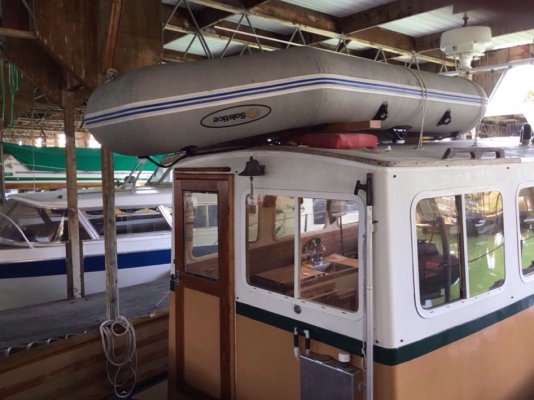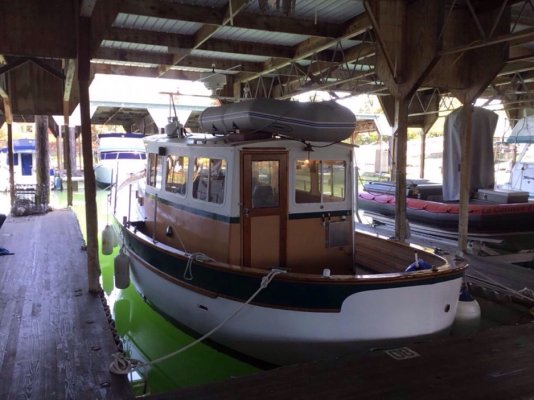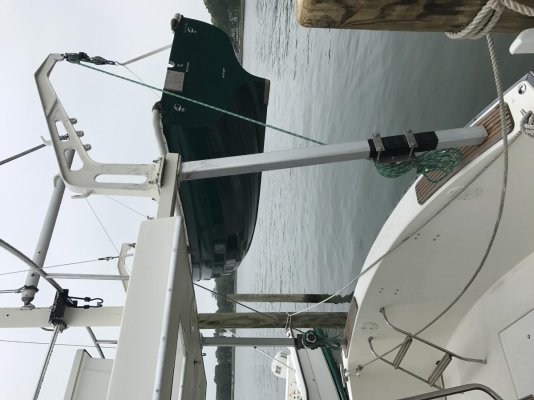You are using an out of date browser. It may not display this or other websites correctly.
You should upgrade or use an alternative browser.
You should upgrade or use an alternative browser.
Different Dinghy Mounting
- Thread starter Nomad Willy
- Start date
The friendliest place on the web for anyone who enjoys boating.
If you have answers, please help by responding to the unanswered posts.
If you have answers, please help by responding to the unanswered posts.
Nomad Willy
Guru
Thanks for the help Craig.
Al
Guru
- Joined
- Apr 1, 2012
- Messages
- 2,206
- Location
- usa
- Vessel Name
- 'SLO'~BELLE
- Vessel Make
- 1978 Marben-27' Flybridge Trawler(extended to 30 feet) Pilothouse Pocket Cruiser[
Eric, you would pass muster in Ketchikan or Thorne Bay with this set up. You have been 'citified' living in the lower 48. Perhaps a haling port or Thorne Bay, AK, would give you phycological cover
You have been 'citified' living in the lower 48. Perhaps a haling port or Thorne Bay, AK, would give you phycological cover . Enjoy the adventure.
. Enjoy the adventure.
Al
 You have been 'citified' living in the lower 48. Perhaps a haling port or Thorne Bay, AK, would give you phycological cover
You have been 'citified' living in the lower 48. Perhaps a haling port or Thorne Bay, AK, would give you phycological cover . Enjoy the adventure.
. Enjoy the adventure.Al
BruceK
Moderator Emeritus
- Joined
- Oct 31, 2011
- Messages
- 13,556
- Vessel Name
- Sojourn
- Vessel Make
- Integrity 386
Eric, that seems to work, see how it goes. If you decide to make it a permanent, you could make some timber supports moulded to the tubes, to hold it in place, and just above the roof. I`ve thoughts of doing that on my aft FB, you could attach them with Sikaflex or similar to avoid screwing into the roof, but it commits you to a dinghy with tubes at a certain width.
ranger58sb
Guru
- Joined
- Aug 21, 2013
- Messages
- 7,346
- Location
- Annapolis
- Vessel Name
- Ranger
- Vessel Make
- 58' Sedan Bridge
Eric, that seems to work, see how it goes. If you decide to make it a permanent, you could make some timber supports moulded to the tubes, to hold it in place, and just above the roof. I`ve thoughts of doing that on my aft FB, you could attach them with Sikaflex or similar to avoid screwing into the roof, but it commits you to a dinghy with tubes at a certain width.
Some of the rooftop mounting systems from Yakima or Thule, for things like canoes, might be useful for ideas. Our (Yakima, I think) cartop system for the canoe can use wide loadbars, and we've got gunnel brackets to keep the load from twisting due to air pressure... The systems are usually modular, so the actual attachment brackets to a (car, truck, boat, whatever) could vary.
The round loadbars do sorta make things easier to slide on, too. I can load our 19' canoe -- from the "stern" of the car -- by myself. Position forward area of the canoe on rear loadbar, go to stern of canoe, lift and push until the weight begins to balance and then tilt so the canoe stern eventually lifts by magic. Push, push, push some more until the whole canoe is balanced on forward and rear loadbars. A couple lines over, tightened with trucker's hitches, E Voila.
Believe the dink would look better on Willy if upside down. Might be easier to push up there that way, too.
Probably wouldn't take much to flip right-side-up as it comes down off the coach roof. I can imagine a somersault, bow down to cockpit, dingy bottom to the transom, bow lifted and the dink pushed over the transom and into the water. With a pre-secured painter, of course.
-Chris
Nomad Willy
Guru
Ranger,
Yes I've loaded canoes that way too. Thule makes an extension bar that slides out so it's end is 3' or so outboard of the car. Put the canoe on the slider bow up stern down. Then pick up the stern and place it in the usual position. Then the bow gets rotated inbd so the canoe is positioned as usual.
For quite a few years now I've been using extended lightweight trailers for most small boat transporting. Extended in both directions. I'm working on a new one now. Or our 14' utility trailer. It weighs 1200# though.
For the trip it will go as pictured in post #31. Yes bow down will help w on and off or up and down. Going down now to make better tie downs and pads.
Yes I've loaded canoes that way too. Thule makes an extension bar that slides out so it's end is 3' or so outboard of the car. Put the canoe on the slider bow up stern down. Then pick up the stern and place it in the usual position. Then the bow gets rotated inbd so the canoe is positioned as usual.
For quite a few years now I've been using extended lightweight trailers for most small boat transporting. Extended in both directions. I'm working on a new one now. Or our 14' utility trailer. It weighs 1200# though.
For the trip it will go as pictured in post #31. Yes bow down will help w on and off or up and down. Going down now to make better tie downs and pads.
1Sailor
Veteran Member
- Joined
- Sep 28, 2012
- Messages
- 76
- Location
- USA
- Vessel Name
- Moondance
- Vessel Make
- Atlantic Prarie 30 LRC
Dinghy Davits on Fly Bridge
The PO of Moondance backed into their slip which made getting off the stern difficult with a dinghy hung on davits, so they put the davits up at bridge level. This seemed fine, but controlling the lifting & lowering of the nice hard dink (an 8' Fatty Knees) we bought very difficult, since it didn't clear the stern & we had to push it away from the stern rail & swim platform while handling it. So I devised a way to make this easier by using two small self tailing sailboat type winches mounted on the bridge support beams. See pictures
The PO of Moondance backed into their slip which made getting off the stern difficult with a dinghy hung on davits, so they put the davits up at bridge level. This seemed fine, but controlling the lifting & lowering of the nice hard dink (an 8' Fatty Knees) we bought very difficult, since it didn't clear the stern & we had to push it away from the stern rail & swim platform while handling it. So I devised a way to make this easier by using two small self tailing sailboat type winches mounted on the bridge support beams. See pictures
Attachments
Al
Guru
- Joined
- Apr 1, 2012
- Messages
- 2,206
- Location
- usa
- Vessel Name
- 'SLO'~BELLE
- Vessel Make
- 1978 Marben-27' Flybridge Trawler(extended to 30 feet) Pilothouse Pocket Cruiser[
Sailor- as we have similar boat model [Marben 27'] do you retain the dink in the hanging position or swing it on to the top in some fashion? Is this placement due to lack of room on the swim step for a 'Weaver' mounting system? https://www.weaverindustries.com/
Asked as there are Weaver mounts for any form of dink besides inflatables. We had mounted our 'Git-A-Home' 9.9 Hi Thrust Yamaha OB on our swim step on a swivel mounted bracket. Then we used aluminum channel to extend the Weaver mounts outboard of the swim step by 4 inches, enough to allow the RIB inflatable to clear this OB in the raised position. Works slick as a whistle, allowing our aluminum canopy over the cockpit area to be utilized for more practicable use. We still can access our swim step in a normal manner as though the OB or the inflatable were not there.
Al-Ketchikan
Asked as there are Weaver mounts for any form of dink besides inflatables. We had mounted our 'Git-A-Home' 9.9 Hi Thrust Yamaha OB on our swim step on a swivel mounted bracket. Then we used aluminum channel to extend the Weaver mounts outboard of the swim step by 4 inches, enough to allow the RIB inflatable to clear this OB in the raised position. Works slick as a whistle, allowing our aluminum canopy over the cockpit area to be utilized for more practicable use. We still can access our swim step in a normal manner as though the OB or the inflatable were not there.
Al-Ketchikan
Last edited:
1Sailor
Veteran Member
- Joined
- Sep 28, 2012
- Messages
- 76
- Location
- USA
- Vessel Name
- Moondance
- Vessel Make
- Atlantic Prarie 30 LRC
Dinghy storage
I keep it hanging from the davits. I keep it from swinging when the boat rolls by putting two "spring" lines on the dink. I use a s/s eye bolt with a length of plastic tubing over the threads, that fits snugly in the or locks, then two lines fore & aft to keep it snug. I'll post a picture of that when I get back to the boat. I was worried about the weight of the dink up so high, so I put 500 lbs. of lead into the keel, under the engine.
I keep it hanging from the davits. I keep it from swinging when the boat rolls by putting two "spring" lines on the dink. I use a s/s eye bolt with a length of plastic tubing over the threads, that fits snugly in the or locks, then two lines fore & aft to keep it snug. I'll post a picture of that when I get back to the boat. I was worried about the weight of the dink up so high, so I put 500 lbs. of lead into the keel, under the engine.
brian eiland
Guru
- Joined
- Jul 17, 2013
- Messages
- 933
- Location
- USA & Thailand
- Vessel Name
- RunningTide
- Vessel Make
- 37 Louisiane catamaran
Zap Cat Dinghy
I think some of you fellows might be in need of a really light weight dinghy.
Other discussions of the idea, and photos over here:
Catamaran tender to replace rib?
...or how about this 'polycraft tuff tender'
Brian Eiland
RunningTideYachts
I think some of you fellows might be in need of a really light weight dinghy.
brian said:So I think the cat form can certainly give him the stability that many tender owners find important. Even that little Zap cat can give good stability.

Now imagine the 'floor/hull' of the tender is nothing more than a flat plate,...pretty easy to fabricate from say a flat panel of nidacore with a suitable skin on either side.
Then why put somewhat complicated and expensive 'inflatable tubes' at either side?? Why not solid foam tubes similar to the foam collar material utilized on the 'SAFE boats'?
Then couldn't those foam tubes be provided with milled channels that would slide over the special configured ends of the flat panel floor board. Designed properly you might not even have to glue the foam tubes on, but rather secure them in place with 'commercial grade velcro' (interlocking mushrooms).
The size and cross-section of the foam tubes would determine buoyancy ...and load carrying.
Other discussions of the idea, and photos over here:
Catamaran tender to replace rib?
...or how about this 'polycraft tuff tender'
Brian Eiland
RunningTideYachts
Al
Guru
- Joined
- Apr 1, 2012
- Messages
- 2,206
- Location
- usa
- Vessel Name
- 'SLO'~BELLE
- Vessel Make
- 1978 Marben-27' Flybridge Trawler(extended to 30 feet) Pilothouse Pocket Cruiser[
I put 500 lbs. of lead into the keel, under the engine.
Good idea in adding weight. At least that is my thinking, these small boats often are a bit tippy and that extra 500# will give a steadying effect. I wonder, maybe due to occupation of the sides area to the engine, that center lining of the weight will produce the offset of the weight of the dink hanging overboard at some height to the center point. Like placing the 500# or some portion there of, off to the starboard side to reflect level when the boat is unoccupied.
Not the case?
Thanks for the post, interesting concept.
Al-Ketchikan
Al
Guru
- Joined
- Apr 1, 2012
- Messages
- 2,206
- Location
- usa
- Vessel Name
- 'SLO'~BELLE
- Vessel Make
- 1978 Marben-27' Flybridge Trawler(extended to 30 feet) Pilothouse Pocket Cruiser[
The weight in the keel,as low down as it can be, centerline, under the engine, keeps the boat balanced & on her lines.
Yep, added a total 1200# lead ingots to our boat. It has 1500# lead built into the keel. Unbelievable how it has settled the boat in all aspects of seas.
NOTE: We added our ballast to offset the lack of fuel/water capacity.
Most of other models of this boat had 200 gallon fuel and 100 gallon water capacities. The OP of this boat chose to go small with 100 gallon fuel and 48 gallon water. In addition, the OP installed a Perkins 4-154 where the more common choice was the Perkins 4-236 or the Ford four cylinder. There is a 500# difference between the two engines.
Al-Ketchikan
Last edited:
eyschulman
Guru
- Joined
- Apr 1, 2014
- Messages
- 1,288
So Eric what about a removable aluminum pipe frame extending from roof over the cockpit. This could also be used for shade tarp when dinghy is in the water
Similar threads
- Replies
- 5
- Views
- 678







